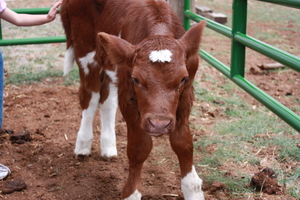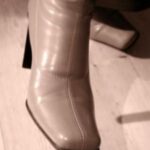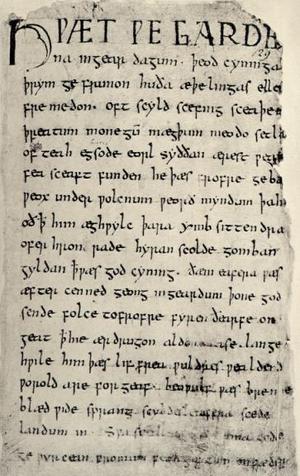Newborn baby animals can get into all kinds of trouble. Living on a ranch, you are responsible for spotting trouble, and helping to correct the situation. Learning to spot a newborn calf in trouble comes with experience. It helps to know all of your cows, when a calf is due, and if cow is in labor.
Recently, I was traveling down the hill from visiting my mom who lives about a quarter mile from me. Most of the herd was busy grazing on the hill and, as I traveled down, I admired all of the calves. I often stop and talk to them and look them over to see if there is a potential problem. While I was driving, I noticed a newborn calf was calling for her mom. I had recently bought several new expectant mothers, so I was curious just who the mother was.
As I watched the calf, I also looked at all the other cows that were close by. All of cows who were close by were cows that had older calves. This newborn calf did not belong to any of them.
A newborn calf is fairly easy to spot. The umbilical cord does not drop for about a week, and the newborn calf is a knocked-kneed klutz still trying to learn how to use its legs. This one could barely stumble about and the umbilical cord, though dry, was intact. This meant the calf was less than 12 hours old.
The day before, Una, one of my favorite cows had been off by herself. Usually, a cow who is in labor will wander off from the herd to have a calf. She will stay away from the herd for the first few days while the she and the calf get to know one another. It is purely instinctual and helps to build the bond between mother and calf. The only time a new mother will leave her calf is to go for water. She will usually walk to water, and then return in a short time as a lone calf is vulnerable to predators.
The mother will bed the calf down so that she knows where to find the newborn calf when she returns. Occasionally, something will spook the calf and it will instinctively run. As cattle are herd animals, the calf will try to locate its mother, but any cow will do. The calf knows the herd will protect it from any predators.
The mother, not knowing her calf has wandered off, will return to where she hid the calf. If the calf is not there, she is normally lost on what to do next. She will start mooing and calling the calf. If the newborn calf does not hear her, the cow will continue to wander around searching.
So, half a mile away was the mother looking for this newborn calf. As I said, newborn calves spook easily and will take off running to escape any perceived threat. So, it is much better to leave the calf alone and locate the mother cow.
I stopped by to pick up my husband and we headed out to where Una had been the day before. Sure enough, she was looking for her new calf, but there was no calf to be found.
Fortunately, the newborn calf was between the corrals and her mother’s present position. Una wanted to remain where she was and to look for her newborn calf, but we were able to coax her to head for the corrals and water.
Una is a pet, so she is fairly tame. We encouraged her in the direction of the calf and trailed behind to keep her from turning back.
When we got to the herd, she took off running towards a small calf. She stopped and sniffed then shook her head, knowing that was not her newborn calf. She turned and watched us curiously, though her baby was just a few yards beyond where she stood.
Finally, the calf called out for her mother and Una’s head snapped around. You could almost see her shocked expression when she realized that her newborn calf was right there. It took her just a moment to cross the distance.
The newborn calf, on the other hand did not know that to think about this huge black cow that was trying to smell her and lick her. She took off running for several yards, her mother hot on her tail.
As my husband and I watched, the newborn calf finally stopped running. Una caught up to her and mooed softly. Mother Nature kicked in and the calf opened its mouth trying to find something to suck. The first thing she found was Una’s neck. It took her a minute to get turned in the right direction and to begin nursing. Once she figured it out, her tail got to twisting with joy and you could even see the relief in Una’s eyes that she had found her wayward, newborn calf.
My husband and I headed back to the house. Throughout the weekend, we kept an eye on the new pair. It seemed this calf was prone to trouble and twice more we watched Una chasing her across the pasture. Una has become diligent about knowing exactly where her newborn calf is, which is great for us. It means we will not have to re-unite them again.
It is small slices of life that make living on a ranch such a joy. I love whenever a calf hits the ground and watch as instincts kick in and mother and newborn calf learn as they go. Then, there are those special newborns that seem to have a knack for trouble. Newborn calves definitely make life interesting.



